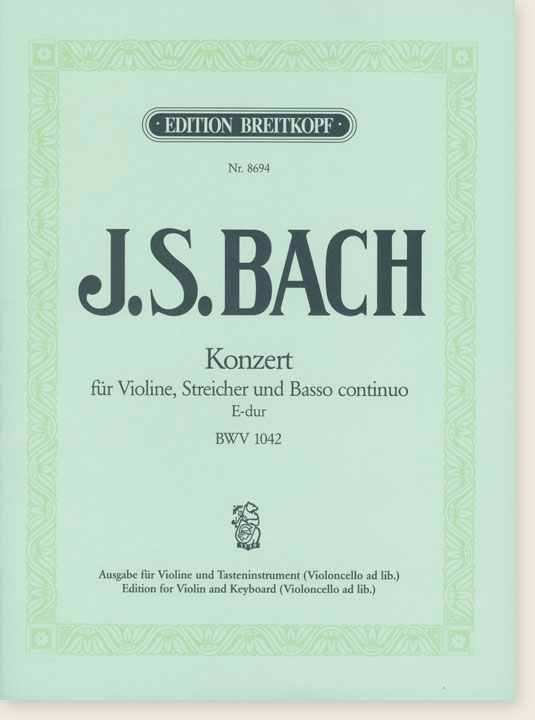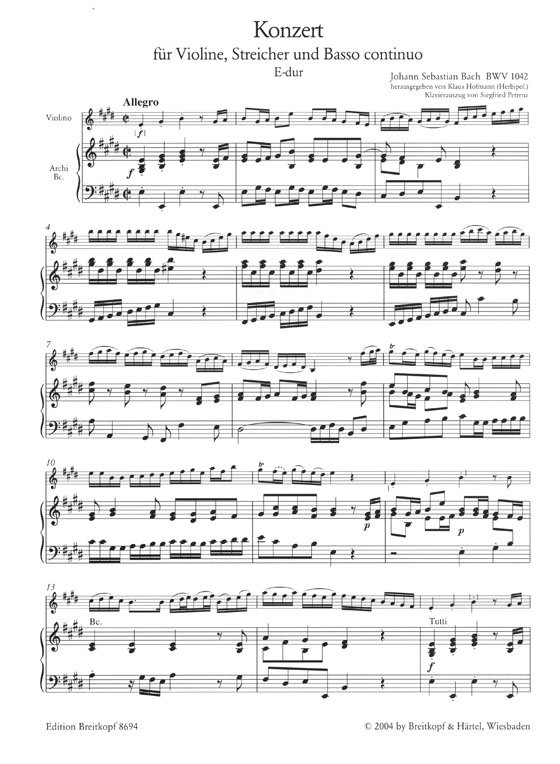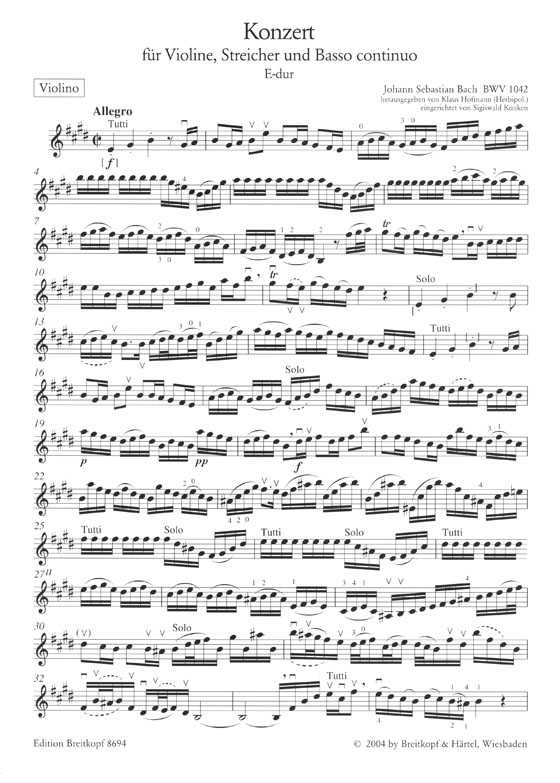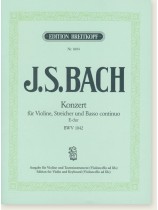Bach Konzert für Violine, Streicher und Basso Continuo E-dur BWV 1042 Edition for Violin and Keyboard (Violoncello ad lib.)






本曲已經成為巴哈作品中最受歡迎的樂曲之一,受義大利作曲家的協奏曲影響,本曲較接近近代小提琴協奏曲,第二樂章的優美音樂,使協奏曲受到熱烈歡迎,曲調十分平易近人,不刻意強調複調音樂的特性,主奏樂器具有明確的個性,巧妙的催生了小提琴的歌謠性。小提琴分譜+鋼琴伴奏譜
- 庫存狀況: 缺貨
- 出版社: BREITKOPF & HARTEL
- 作者: Johann Sebastian Bach
- 編訂者: Klaus Hofmann
- 總書頁: 49
- 商品編號: Nr8694
- ISBN: 9790004181829
簡介
With Sigiswald Kuijken, the Baroque-violin expert, another celebrated performer puts his valuable experience at the disposal of Breitkopf & Härtel and its new editions. Bach’s E major concerto still presents interpretative questions that have yet to be answered. The slurring of the solo part is sometimes quite incredible in the main source. And it is even doubtful that it stems from Bach himself. All the more important are the experienced soloist’s suggestions for a stylistically accurate interpretation.
In his edition for violin and keyboard instrument, Klaus Hofmann goes so far as to supply three violin parts (the first from the new score, the second with markings and notes by SigiswaldKuijken and the third as a facsimile of the main source). The performer is thus thoroughly informed and able to make his own competent decisions. Siegfried Petrenz has realized the continuo part sparingly and idiomatically.
Bach’s Violin Concerto in E major BWV 1042 only gradually found its way into public concert life after the publication of its first edition, prepared in 1857 by Siegfried Wilhelm Dehn and published by C. F. Peters in Leipzig, and the edition prepared by Wilhelm Rust and published in 1874 as Volume 21/1 of the Bach-Gesellschaft’s Complete Edition. However, it has since entered the pantheon of classical violin literature along with its fellow work in A minor BWV 1041, and has been part of the repertoire for nearly a hundred years now.
Bach scholars have traditionally attributed the concerto to Bach’s Köthen years, when he was court conductor (1717–1723). Unfortunately, its original sources have not been transmitted; it has come down to us only in copies made at a later date. The earliest and most important of these sources is a score of both violin concertos which dates from about 1760 and was part of the estate of the Berlin musician Johann Friedrich Hering (1724–1810). This score is located today in the Music Division of the Staatsbibliothek zu Berlin under the shelfmark Mus. ms. Bach P 252. The scribe is an unidentified Berlin copyist who seems to have worked for Hering. Hering himself manifests his presence in the copy through various addenda. Moreover, one finds a number of indications (in particular, many references to the alternation of “Solo” and “Tutti” in the solo part) which were added by Carl Friedrich Zelter (1758–1832). In 1800 Zelter became the director of the Berlin Sing-Akademie, where the work was performed several times between 1812 and 1814.
The Berlin Staatsbibliothek also preserves a set of parts copied by the scribe of the score P 252, which bears the ownership note “Hering: 1760” (shelfmark: Mus. ms. Bach St 146) as well as a score written by an unknown scribe, presumably for Zelter (shelfmark: Mus. ms. Bach P 253) and a continuo part from the early 19th century (shelfmark: H 729). All three manuscripts, however, are based on P 252, as is claimed in the Critical Notes of Volume VII/3 of the Neue Bach-Ausgabe prepared by Dietrich Kilian. This is why only this source was important in the preparation of this edition.
Outside of these sources, Bach’s lost original score also left an important trace in the form of the revision and arrangement of the work into the Harpsichord Concerto in D major BWV 1054, produced around 1738. The autograph score of this version is found in the manuscript Mus. ms. Bach P 234 of the Berlin Staatsbibliothek. It fulfills a major service at dubious and erroneous readings of the source P 252.
Our edition basically follows the manuscript P 252. It faithfully renders the music text in a uniform manner according to modern-day notational practice; this concerns notably the setting of the accidentals and expression marks. There are three passages (mvt. I m. 77, mvt. II m. 31 and mvt. III m. 140) in which doubts could arise as to whether our main source has transmitted the solo violin part correctly. At these passages we have provided an alternative, namely the reading of the solo part as found in the harpsichord version. Further information can be found in the “Revisionsbericht” (Critical Commentary). We were also prompted, albeit for different reasons, to borrow the harpsichord version for mm. 119f. of the first movement. P 252 apparently presents the original reading here, but Bach later – when arranging the piece for harpsichord – seems to have developed reservations about the last of the auxiliary-note figures on the third quarter of m. 119 and the first and third quarters of m. 120 which leap out of dissonances. He thus altered the original version that had already been entered into the score, changing it in the sense of the variant reproduced in the ossia staff in our edition.
One special problem is the slurring found in the main source: it is extraordinarily negligent, irregular and imprecise. One has the impression that the scribe placed the slurs carelessly, at random, without troubling his mind in the slightest about their musical and performance- technical significance. Of course, it cannot be excluded that such unreliable markings were already contained in his source. At all events, the result is generally as unclear as it is equivocal, and forces one to constantly weigh both musical and performancetechnical aspects. On the whole, our setting of the slurs can only be seen as an approach to what was originally meant. It does not exclude other solutions. Since this problem concerns almost exclusively the solo part (and here the harpsichord version of P 234 offers little help), we are reproducing the part in the Appendix as a facsimile of the respective sections of the score according to P 252. The performer can thus make his own picture of the source and eventually develop his own solutions.
The harpsichord version in P 234 is helpful in determining the interpretation of the articulation marks in the orchestral parts. At the ritornello of the finale, which is heard five times and bears somewhat different markings each time in P 252 even though there is no visible motivation for this, we have decided to uniformly borrow the articulation form found in P 234 for all the ritornellos.
Aside from the exceptions mentioned here, we have indicated additions to the source text in the score through brackets and brokenline slurs. All of these additions are based on the principle of analogy and are limited to this principle; they make no claim to provide an exhaustive marking.
The thoroughbass figuring has been uniformly reproduced in modern transcription, whereby the missing figures have not been supplemented. On the whole, it is very fragmentary and occasionally inconsistent. It can no longer be determined whether the figures were set down by Bach or by an arranger. In view of the rapidly repeated thoroughbass notes in the first movement (mm. 9f. and often afterwards), the harpsichordist would do well to remember Carl Philipp Emanuel Bach’s recommendation to strike only the first, third, fifth, seventh etc. note of a sixteenth-note sequence in such cases. The “Revisionsbericht” supplied at the close of this edition provides further information concerning details of the editorial process.
We wish to extend our cordial thanks to the Music Division of the Staatsbibliothek zu Berlin – Preußischer Kulturbesitz for its permission to use the manuscripts. My particular thanks go out to Sigiswald Kuijken, whose advice helped me enormously in my interpretation of the slurs in P 252.
Göttingen, Spring 2004
Available for sale:
Parts OB 5355
Edition for Violin, Keyboard and Violoncello (ad lib.) by Siegfried Petrenz EB 8694
This edition contains four separately enclosed parts:
– Solo part
– Solo part with fingerings, bowings and comments on performance by Sigiswald Kuijken
– Facsimile of the Solo part from P 252
– Violoncello part
目錄
Song List:
Violin Concerto in E major BWV 1042
音樂表演廳
詳細規格
| 書籍資訊 | |
| 記譜法 | 五線譜(一般) |
| 原文語言 | 德文 |
| 特徵 | 西洋古典 |
| 樂器 | 小提琴 |
| 古典作曲家 | Bach J.S 巴哈(巴赫) |
| 時期與風格 | 巴洛克樂派 |
| 裝訂 | 平裝 |
| 形式 | 譜 |
| 外型尺寸 | 大於A4 樂譜常用尺寸 |

